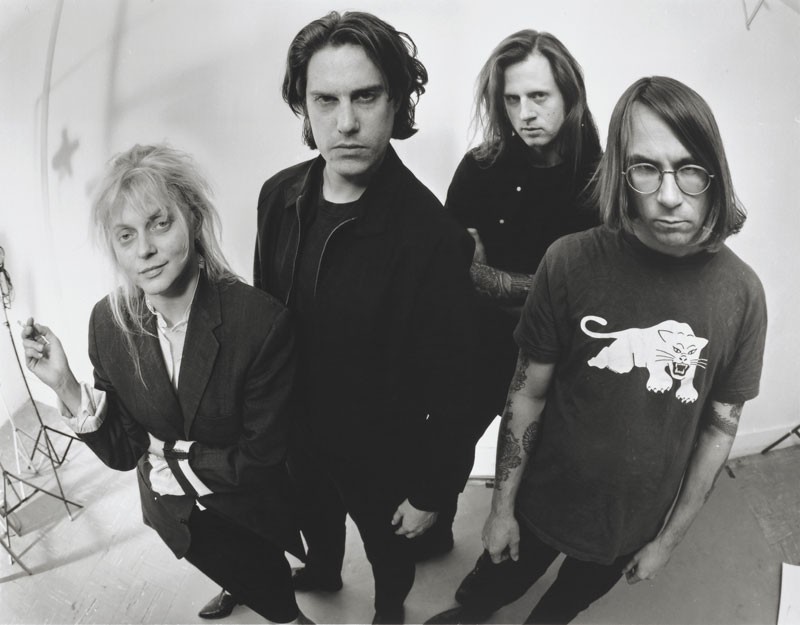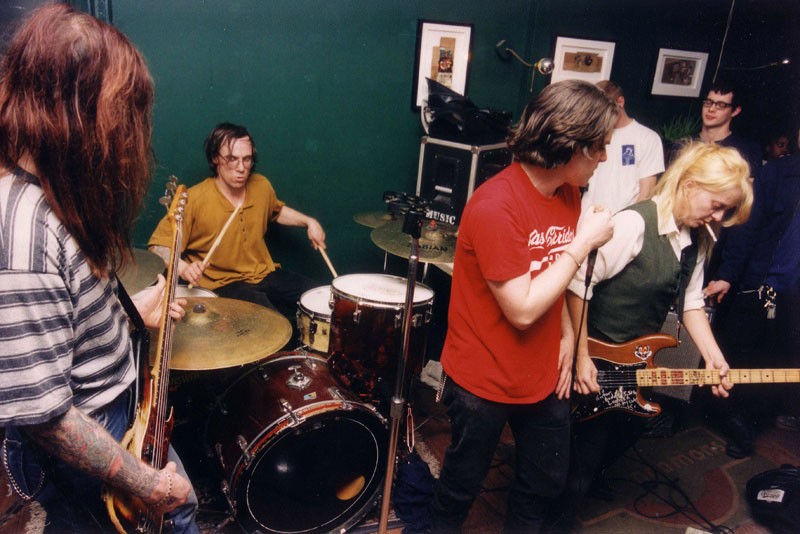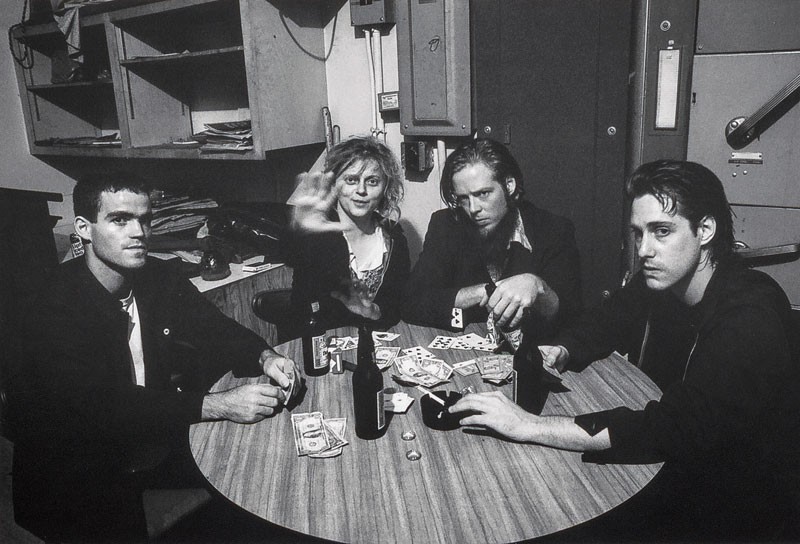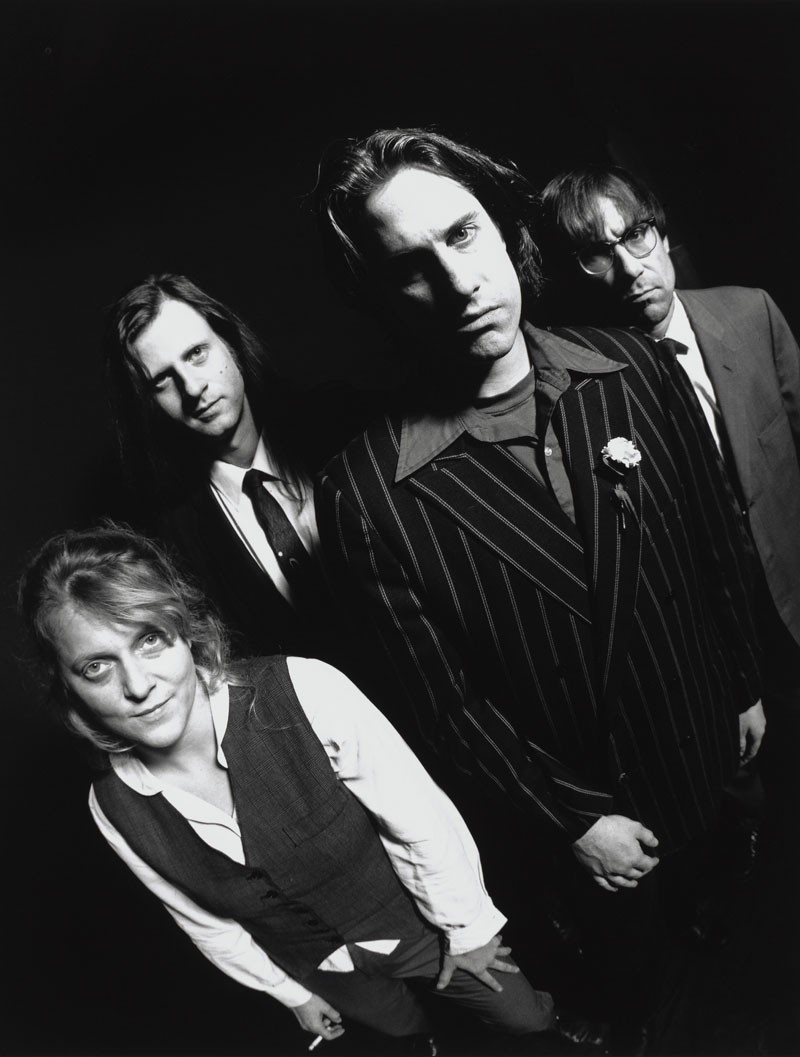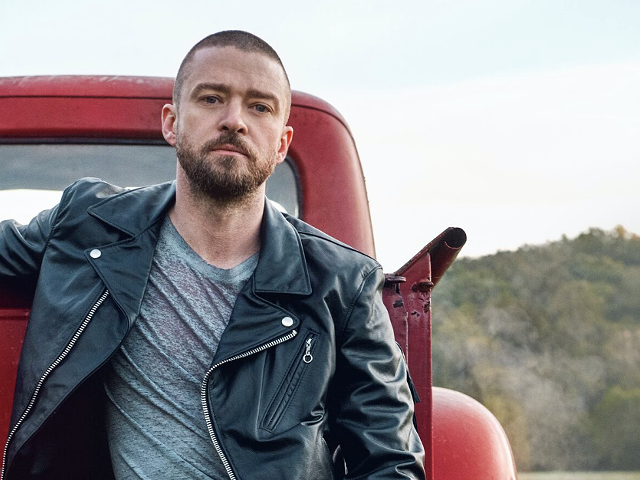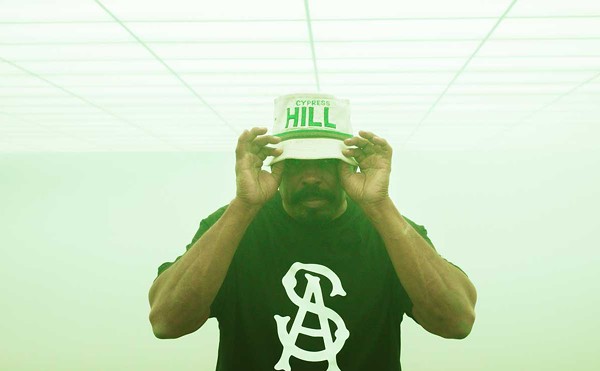Vocalist John Brannon is at Detroit's Third Man Records reminiscing about his former band the Laughing Hyenas, and the irony of it all is hard to miss. In 1984 he lived around the corner from where we are, only to later flee for Ann Arbor with his fledgling band. They were tired of their gear being stolen. The neighborhood was a bit too rough.
A visitor from 1984 wouldn't recognize the neighborhood now. Third Man Records Cass Corridor is the Detroit outpost for the record label of Jack White, one of the rock scene's biggest stars, and it houses a sprawling storefront, a small venue, a vinyl record pressing plant, and a recording studio. On one side of the building is high-end retail and on the other side is a brewpub. Across the street, there's more retail and another brewpub.
It's the perfect spot for Brannon to reminisce, though. Key spots from his personal history are all a stone's throw from here. The Freezer Theater was around the corner at 3958 Cass Ave., ground zero for the nascent Detroit hardcore scene in the early '80s and where Brannon's previous band Negative Approach played many times. The Clubhouse, where the hardcore scene moved after the Freezer Theater shut down in 1982, was around the corner from there, at 406 W. Willis St. Negative Approach practiced there, as well as L-Seven (not to be confused with the L.A. rock band, L7), Brannon's girlfriend and future bandmate Larissa Stolarchuk's first band. Brannon and Stolarchuk also lived there.
Further down Cass Avenue is Little Caesars Arena, where Negative Approach played a triumphant warm-up set for White's big hometown show earlier this year. Just outside of where LCA now stands, Brannon was busted for heroin possession almost 20 years ago. The 13th Precinct, now closed, is over at Woodward Avenue and Hancock Street, where he spent four days in jail going cold turkey after that bust. And just down Canfield Street from Third Man is the Traffic Jam & Snug restaurant where Brannon has worked for 20 years now, when not on tour.
So it's perfectly fitting that Third Man Records is reissuing the Laughing Hyenas catalog on vinyl: Brannon is arguably the rock 'n' roll ambassador for the Cass Corridor. As one would expect from Third Man, the reissues are meticulous, featuring previously unreleased tracks and new artwork with rare photos and flyers, and were remastered by Shellac bassist and mastering guru Bob Weston.
In spite of some hard living during the Hyenas, Brannon has a sharp memory and a knack for storytelling, prefacing everything with his signature "check it out" pronounced as if it were one word. In person, he's funny, personable, and down to earth — completely unlike how he is behind a microphone.
On stage, Brannon is a menacing beast, pacing around and leering at the crowd, singing in a cathartic superhuman howl that seems like it should be physically impossible. No larynx should be able to withstand that level of abuse. To the novice, it's not uncommon to feel like Brannon's voice is an assault — that he's just screaming.
But he's not just screaming. He uses dynamics. He'll hold back on the verse of a song just so he can unleash the full fury of his voice on the chorus. With the Hyenas he would sprinkle in a couple ballads on an album and just sing — much like his idol Iggy Pop did with the Stooges (think "We Will Fall" or "Dirt").
Remarkably, Brannon never blows his voice out. He's a physical marvel. He can still sing like he did 30 years ago. For that reason, he's easily one of the all-time greatest rock 'n' roll vocalists. A preacher's son, he's taking you to church in his own way.
The Laughing Hyenas emerged from the ashes of two of the greatest early '80s rock bands from Detroit's Cass Corridor. Brannon was the vocalist for the hardcore band Negative Approach, an influential hardcore band. Along with bands like Minor Threat, Black Flag, the Misfits, and Touch and Go labelmates the Necros, Negative Approach helped draw the blueprints for hardcore punk. Meanwhile, Stolarchuk was the equally charismatic vocalist for post-punk band L-Seven. Although the band only released a three-song seven-inch on Touch and Go (which Third Man also plans to reissue along with unreleased material), L-Seven's influence in Detroit was deep. The band opened up for most of the major touring punk and post-punk bands playing in Detroit at the time.
In spite of the success, Brannon and Stolarchuk felt they were at artistic dead ends with their respective bands, and wanted a radically different musical direction. The only common denominator to either of their past bands would be Brannon's powerful voice.
The Hyenas would go on to play with and count some of the greatest bands of their era as fans: Sonic Youth, Fugazi, Dinosaur Jr., Mudhoney, and the Minutemen, to name a few. Their first three records were the inspiration for Nirvana to record Nevermind with producer Butch Vig. Stolarchuk, who had never played guitar before, would become a strong presence in the indie rock boys' club.
But the Laughing Hyenas never enjoyed any large-scale success. Just a decade after they started, the band fizzled out in 1995. A combination of its extreme sound and a cloud surrounding its drug use kept the band from a larger audience and even any decent press coverage.
But with the occasion of Third Man reissuing the Laughing Hyenas' catalog, we tracked down all of the surviving members and key players and compiled the interviews into one deep dive on one of the great unsung Detroit rock bands.
Metro Times: How did the band start?
John Brannon: The band started while we were still living in the Cass Corridor. A big thing was when L-Seven played with the Birthday Party at Traxx [a Detroit venue], and at that point we're like, "Oh my god, this is the future of rock 'n' roll." It was right when [Negative Approach's first album] Tied Down came out. I started rethinking things then because I really held them as the future of rock 'n' roll.
It got to the point where me and Larissa were staying at the Clubhouse and our equipment kept getting ripped off, both our bands broke up, and we were going to start a new band. At that point we were together with our first drummer Mike Danner. One day we just got in my van and we drove to Ann Arbor. We had no place to stay — we lived in our van for a couple weeks.
We used to go to the Michigan Union ballroom and just crash out on the couches there because they had cable and a place we could piss. We'd raid frat houses and say we "knew John," because there was always a John at a frat house, and we'd eat their food. We had no money, and it's just like we went there with the idea we were going to form a band. We kind of slummed it for a while.
We eventually got jobs and got a house together. It was the three of us, and Mike knew Kevin Monroe. He became our bass player and moved into the house. At that point we had a pact. That was the beginnings of the Laughing Hyenas.
Mike Danner: When Kevin joined, Larissa was playing bass at that time. She had played bass with me in the Eleventh Episode. It was bass when we were first jamming and then she moved to guitar. Thank God. That was her calling.
Kevin Monroe: I was going to play guitar but John and Larissa wanted to make sure that the sound didn't change. If they had a guy playing guitar and Larissa played bass they were worried that their whole sound would disappear if the guitar player quit the band.
And I'm like, "So, I'm going to be the bass player who's indispensable. I got to write some songs that will be so bass-oriented that they can't get rid of me." I really, consciously, thought about trying to develop riff basslines. It's like, I'm playing rhythm guitar on bass and then Larissa gets to put the icing on the cake with her guitar playing and her style.
John Brannon: Larissa had never picked up guitar, she just kind of learned her own way. She wasn't affected by learning Eric Clapton or Led Zeppelin, she did it by feeling. My idea was to get a band together that wasn't affected by the whole rock thing, that could do something totally unique and start fresh.
We just came out of the hardcore thing that had played its course, where it was becoming stupid and repeating itself. That was the nucleus of the band, us all having a house together, hanging out together, and jamming in the basement every night. We weren't the greatest musicians, but we really wanted to do something original and unique, and take what we had for our influences — Alice Cooper, the Birthday Party, and the Gun Club — and try to build on that. That was the start of the band. Our first gig was was at Joe's Star Lounge [in Ann Arbor]. We warmed up for Destroy All Monsters.
Mike Danner: With Mike Davis [the former MC5 bassist].
John Brannon: We were buddies with Mike Davis. That was a thrill for us because we had just moved to Ann Arbor.
Mike Danner: We rehearsed like crazy. We were trying to find our sound, trying not to sound derivative and not to sound like our obvious influences. And it seemed tough at first. Because it seemed like years went by and we had, like, six songs.
Kevin Monroe: We lived very meagerly, that's for sure. Then we would just practice and practice in the basement. So that's why the music is the way it is, I think. Even when different people moved out or whatever, we still had already sort of retained what we had developed from living together for a long time.
Metro Times: How did Negative Approach fans react to your new band?
John Brannon: People were still holding on to that super hardcore thing. The Hyenas did not go over well with the punk audience. I think '86 is when we first started having good songs — all the songs that ended up being on Merry Go Round. We recorded demo versions at some east side [Detroit] studio. It wasn't that good, but we had the blueprint for Merry Go Round. I remember we gave that to Touch and Go, and they were like, "You guys aren't quite ready."
Kevin Monroe: The guys [at the studio] really had no familiarity with the kind of music we were playing. It's flat. It's not nearly as interesting as Butch Vig's treatments of stuff. Corey [Rusk, owner of Touch and Go] wanted to put the album out, but he wanted us to re-record it.
Corey Rusk: We waited a while, while they developed their sound, before agreeing to release their records. By 1985, hardcore was pretty much over and many of the early hardcore musicians were moving on. John was making his own transition into something that felt different and exciting.
In 1986, disagreements over touring, recording, and the stresses of living together led to Mike Danner's departure.
John Brannon: The nucleus of Merry Go Round was already laid down, and at that point Mike left the band. So we put a call out for another drummer, we put an ad up at [Ann Arbor record store] Schoolkids Records. The only person that answered the ad was Jim Kimball. We had Jim learn the songs and then we got a record deal with Touch and Go.
Jim Kimball: I was very fortunate in my timing to come into the band. At Schoolkids Records, there was a notepad piece of paper on the wall. It said, "Wanted, punk blues drummer," with little tabs torn on the bottom with a phone number. I didn't know any of these guys at all.
Kevin Monroe: Jim walked into a crazy world.
The only thing that we had a problem with when Jim first started was we wanted him to hit harder, and oh my god, did he start hitting the skins hard. I mean he was like a maniac.
Jim Kimball: Yeah, my style developed. [I switched] to thicker sticks with no tips on them.
John Brannon: Jim really came from a jazzy style, and we're like, "Jim, play a little harder," and I think Larissa and I might have created a monster. He became one of the hardest-hitting drummers of all time. From the beginning with Mike it was really like a tribal feel, and Jim had this light tap finesse that was totally unique. We wanted it to be more tribal so we were like, "Jim, don't tap, pound."
Meanwhile, Stolarchuk had become every bit as a unique presence on stage as Brannon. With long blonde hair and pale blue eyes, she would alternately be decked out in thrift store dresses or more androgynously suited up in dress shirts and slacks (but never jeans), standing with her '72 Fender Stratocaster and unleashing a sonic assault through her Fender Twin Amp. Her playing style is physical, but not overstated — when you play that loud, just moving the guitar around can change the whole sound.
Butch Vig: It was such an odd juxtaposition — the visual impression and the sonic assault were totally at odds with each other.
John Brannon: There was nobody like her, nobody that dressed like her, or looked like her. She just had a badass attitude and didn't take any shit from anybody. I was just in awe of her. She was just a totally strong individual and unique artist.
Larissa went to Parsons, she was a total artist. She approached things differently, she introduced me to a work ethic and approaching things as an artist. Down the line she basically managed us, booked all the shows, did all the artwork, drove the van — she was the one that really got us out there and just did everything.
She wasn't your typical guitar player. There's nobody that plays like her, and I mean she played just as hard as anybody. To people that got it, I think that really set us apart. But a lot of people didn't get it and there was still that thing like, "A chick can't rock." Also a lot of women in bands at that point were always the bass player. We'd go to the club and they'd be like, "Oh, are you the bass player?" I'm like, "No, she's the fucking guitar player." We always had to deal with all that macho shit about dudes putting girls down being in bands. I was like, "Fuck you man, try to do what she does, I don't think you can do it."
Kevin Monroe: Larissa was really influential to me in different ways. She was always sort of like a big sister or matriarch.
But her influence was mostly in the art sort of thing. She went to Parsons and she was always painting pictures or drawing, and she was quite good at it. Her influence on the way we were going to present ourselves and be in the band was thoughtful.
That's why the Hyenas were like a thing, like something beyond just the music. Like I said, we were in this sort of club.
She would talk about how some friends in New York had influenced her. They didn't even talk to other people unless they were artists. They were mostly just trying to expand the way they thought and the way they approached whatever medium that happened to be their thing.
She did that when it came to music. She started off not ever having played guitar before, and then applied the stuff that she had learned in art school and throughout her life to the instrument in an unconventional way, and that's why we sounded different as well.
Also, it is important to know that both Larissa and I were just basically new to our instruments that we were playing. That made it different too, that we were creating a sound for ourselves on these instruments without actually having past experience with them.
Jim Kimball: I would have to concur. The artwork she did for show posters was always very meticulous.
The Hyenas go to Smart Studios in Madison, Wis., in September 1987 to work with Vig. The band will end up recording their first three records with him.
Metro Times: How did you guys got hooked up with Vig? I know he was a main Touch and Go producer, but it just seems very fortuitous that you guys worked with him on your first three records because he understood your sound and actually deepened it. It seems like some producers might not know how to relate to you guys.
John Brannon: He was really cool with us, and kind of let us produce it with him. We told him what we wanted, we had a vision of how we wanted to be recorded, and he just went with it. He was amazing.
I had read a Stooges interview where Iggy was talking about how they recorded Fun House. They brought a live PA in the studio and they recorded his vocals with a hand-held mic through the PA.
In the back of my mind, that's how I always wanted to record my stuff. So I brought all my stacks in there, and he goes, "I've never done anything like this." I go, "Well, the Stooges did it this way, we're going to do it too." So he put microphones in front of a live PA, because we worshipped the Stooges. Fun House was the greatest album of all time to us, and we wanted to do it like they did it. He just went with our vision and totally hooked us up.
Butch Vig: Corey Rusk kept saying, "You got to work with this band, man. They're ferocious." He told me they were primal sounding. He sent me a demo and said, "Trust me, they sound way more intense live than this," and he was right. They had a really unique sound.
‘It was like the fillings in your teeth would fall out, it was so fucking intense.’
tweet this
Metro Times: What was it like recording with them?
Butch Vig: I think Larissa just set the volume [on her amp] to 10. I'm not kidding. And those Fender Twin amps are fucking loud at 2.5 or 3. It was like you couldn't get in front of it. It was like the fillings in your teeth would fall out, it was so fucking intense.
One of the things that really kicked it up a notch in the studio on the records I did with them was we brought their [vocal] PA in the studio. We miked the PA so things were split. A mic input would come to the console so I could run it to the tape machine and it would also be split back to the PA so we could turn things on in the PA, and that gave it an extra, just overwhelming crunch.
The sound decibels in the room were just really intense. It was an intense-sounding room to begin with and when we brought their PA in, oh my god, it was just crushing. And you can hear that in the tracks. If we had taken the PA out it still would have sounded really intense, but it would have sounded a little bit more studio.
The band was super cool to work with. I want to say each record was done in like five days, which was a typical Touch and Go budget. Corey knew we had to get a record done. Three or four days of recording, couple days of mixing. That's kind of the way it was back then.
Metro Times: Speaking of Touch and Go budgets, do you remember what the budgets for those records were?
Butch Vig: I don't, but I want to say they were probably about three grand, just because it was no longer than six days. For the studio engineering, it was about 500 bucks a day. We were efficient back then. We had to be.
The Come Down to the Merry Go Round EP is released in November 1987, where Monroe and Stolarchuk both claim the last name "Strickland" on the record's liner notes. Locally, the Laughing Hyenas open for all of the major indie acts coming through town: Hüsker Dü, Redd Kross, Big Black, and the Butthole Surfers. The next year, Sonic Youth takes the band out on the road to warm up for its Daydream Nation tour. Before they head out with Sonic Youth, the Laughing Hyenas record a follow-up album, You Can't Pray a Lie, once again with Vig at Smart Studios.
Kevin Monroe: We were developing as a band. On that first album we were just sort of getting started. I like a lot of the songs on the first album. My personal favorite is the third album, but I like a lot of songs on this.
Jim Kimball: You Can't Pray a Lie's my favorite.
Kevin Monroe: I knew you would say that.
Jim Kimball: There wasn't much time after I joined the band that we went and recorded Merry Go Round, so when we were working on You Can't Pray a Lie, it was really coming together organically. I felt my purpose more in how my playing was developing.
Kevin Monroe: That's because you were playing your songs, not somebody else's drum beats. I think my favorite song from the Hyenas would be "Lullaby and Goodnight" because I really like the bassline on it.
Jim Kimball: That's my favorite song, too, it's just like everything came together. Butch made that song really explode.
Metro Times: Butch, your band at the time, Fire Town, was sonically very different. How did a guy in a jangly pop band get drawn into and understand the Hyenas' sound?
Butch Vig: I'm a drummer. I love the way that the rhythm section sounded in the band. They just had a fuckin' powerful, groovy feel. A lot of times I would have to do editing, particularly with bands where the drummers weren't very good. I'd do a whole bunch of takes. I didn't have to do that at all with the Hyenas. We would do two or three. Once we had the sounds up on everything and they'd run through and I'd double-check everything, it was usually one or two or three takes, tops.
Larissa was really good too, spot on. And that's something that a lot of bands who I work with don't have. I spend a lot of my time in studios trying to make bands sound tighter and more focused. I didn't have to do that with the Hyenas. They were fuckin' really tight. Their arrangements were great too because they had those little moments where it sort of cleared out like a breath of fresh air in the song, but then you knew you were going to get hit with another assault momentarily.
And John definitely did that with his vocals too. He knew that he could sing from a whisper to a scream quite intensely. As a band I think they realized that was an important part of performing live, is to give your audience a rollercoaster ride with those kind of dynamics. And they got very, very good at it.
John Brannon: Merry Go Round had its sound, but I think Jim [added] his style on the second album, [and] Larissa got more comfortable playing guitar. Her and Kevin wrote most of the riffs on that whole album. At that point Larissa was like, "Just concentrate on the lyrics," so I let them write the music. The first album was definitely influenced by other bands, but by the second album they really came into their own and created their own style. By Life of Crime [the Hyenas' third record] we kind of had it down.
You Can't Pray a Lie is released by Touch and Go in March 1989. The Hyenas tour to support the album. The band is musically in full stride. At the same time, the seed of the band's undoing is planted: Brannon and Stolarchuk's heroin addiction is becoming increasingly apparent.
Metro Times: When did heroin enter the picture?
John Brannon: Probably just around the beginning of Laughing Hyenas. Dabbling. Dabbling became doing. It was a vicious circle that we all had to go through. It was not a good choice at the time. I don't suggest it for anybody. We kind of just got caught up in the vicious circle. Once you're into it, just trying to get off it is impossible. We definitely had our ups and downs. I think it probably ruined a lot of opportunities for us because people were scared of us, just because of the whole drug aura. I mean it's nothing that we ever tried to promote or anything, but it was obvious.
The Hyenas head to Smart Studios in June 1990 to record their third and arguably best album, Life of Crime. It would be the last album with the initial recording lineup. The previously unreleased song "Save Me Tomorrow" from the sessions appears on the Third Man Records reissue. On the original master tape, it was titled "Sexy Rocker."
Metro Times: Butch, it seems to me those Hyenas records had a lot to do with Nirvana recording Nevermind with you.
Butch Vig: It totally did. Jonathan [Poneman] from Sub Pop gave those records to Kurt [Cobain] and Krist [Novoselic] from Nirvana. Also Billy Corgan. Billy had been listening to the Laughing Hyenas and Killdozer records that Touch and Go had been putting out. Those records were very influential for me working with Nirvana and me working with Smashing Pumpkins.
Metro Times: That makes all kinds of sense to me. The Hyenas and Nirvana have two of my favorite rhythm sections in bands from the era.
Butch Vig: Yeah, Nirvana, another band that I didn't really have to edit. As much as people thought they had a slacker mentality, they were the exact opposite of that. When we went in to record Nevermind, they had rehearsed every day for six months. And they were fuckin' tight, too.
John Brannon: The first time we met Kurt we were playing with Mudhoney and Sonic Youth at the Ritz. We were all backstage, it was like Lydia Lunch, Foetus, Dee Dee Ramone, it's like all the fucking rock stars are hanging out and that's when we first met Kurt Cobain and Tad [Doyle, of Sub Pop band Tad]. I remember Tad came up to me and he's like, "Hey man, I turned this dude on to the Laughing Hyenas," because Tad really liked Merry Go Round and I think You Can't Pray a Lie was out at that point too. And this is the first time I ever talked to Kurt, he just came up to me, he's like, "I really like the sound of your records," and I'm like, "Thanks man, you should go check out my guy Butch Vig." So I was basically just giving him a tip — like, hey, go check out this dude — and then, of course, the rest is history.
It's kind of funny, we were in there recording Life of Crime and Butch had just recorded "Smells Like Teen Spirit." We were loading our stuff in to set up for recording and Butch is like, "I just recorded Nirvana, do you mind if I work on the mix here? I think this one's going to be a single." So in hindsight, I got to say we were probably one of the first ones to ever hear that song outside of the band. We were like, "Oh, this is pretty good." We didn't realize they were going to become the Beatles. [Laughs.] But it was one of those things, right place, right time. It was kind of exciting.
Life of Crime is released in September 1990, and the band tours extensively to support the album. But by 1991, Kimball and Monroe have grown frustrated with the band and leave to start their own band, Mule, with Wig guitarist and vocalist P.W. Long. Brannon and Stolarchuk cease being a couple but remain determined to keep the band going, enlisting Todd Swalla from the Necros to join.
Jim Kimball: We felt the band had run its course. Kevin and I wanted to branch out and try something new.
Todd Swalla: Kevin and Jim had quit the band and my band had broken up. I think John just kind of called me out of the blue to start jamming. Larissa was in Florida.
Metro Times: Did the Necros and Negative Approach play together a lot?
Todd Swalla: In the beginning, yeah. Negative Approach played their first show in my mom's basement. When we each started touring, not so much.
Metro Times: What was it like having to replace and sound like another rhythm section?
Todd Swalla: It was kind of daunting for me. I thought Jim was way better than me. I'm like, "I can't play this stuff." I learned how to play them on my own terms, but it almost took me about a year to really get myself gelling on his songs that I had to play.
With Vig in high demand after the release of Nevermind, the Laughing Hyenas head to White Room Studios, located at 1145 Griswold St. in Capitol Park in Detroit. They record their EP Crawl with producer Al Sutton — who would later produce acts like Kid Rock and Greta Van Fleet — in 1992.
Al Sutton: The Hyenas called me, probably because Butch was too busy from his Nirvana success to get them in. We did that in four or five days over the Fourth of July weekend.
Metro Times: Was Brannon still recording his vocals through the PA?
Al Sutton: Well, that's a funny story. John was in the little inside room at White Room. The PA was set up in the big outside room blasting all day long when we cut vocals while the windows that overlooked the park on the north side of the building were open. White Room was on the third floor.
The guy who owned the store on the main floor sent one of his guys up to see what the hell was going on because all they hear is this screaming coming through this loud PA booming through Capitol Park. This dude comes up and he goes, "We thought somebody was getting murdered up here." And he walked in the control room and he sees John in there screaming into the mic, and he just looked like he didn't understand what was going on. He was just bewildered. He goes, "He's going to go hoarse if he keeps doing that." Then he just walked out. And I'm sure the people hanging out in the park were probably just wondering what the hell was going on up there.
Metro Times: And Larissa was still just recording with her amp on 10?
Al Sutton: Yeah. I remember she wouldn't put her headphones on all the way. She thought that it'd be better to have one ear off, but her amp was so blisteringly loud that she couldn't hear [through] the headphones. So she kept going, "Turn up my headphones, turn up my headphones." Her headphones were so loud for so long that they became hot enough to actually burn her ear. She didn't even really care. And I'm looking at her astounded. Like, you didn't feel that burning your ear before it got to blister?
Metro Times: Kevin Ries plays bass on the EP but then disappears from the picture. What's the story there?
Todd Swalla: John had recruited Kevin from Cleveland. He came up for the recording of Crawl. After that he wanted to take his girlfriend on tour. Everybody [in the band] was like, "We don't take girlfriends on tour." She kind of made him quit after.
Metro Times: So did that version of the band with Ries tour at all?
Todd Swalla: Just once. Just the East Coast.

Crawl is released in October 1992. Shortly after, bassist Kevin Ries quits. He dies from an overdose shortly after leaving the band.
Metro Times: So Ron Sakowski, former Necros bass player, was recruited after Kevin Ries quit?
Todd Swalla: Yeah, pretty much. I think that was my idea. I'm like, "Well, I could call Ron." And Larissa was like, "Really?" Sure enough, he pretty much got the job the next day and showed up, started learning the songs.
I think we got a set together fairly quick and hit the road. That was the official Crawl tour. That was like a cross-country thing. Because we didn't have another record for a couple years.
Ron Sakowski: I remember getting a call from Todd asking if I was in any bands at the time. John, Larissa, and him were starting to reform the Laughing Hyenas. Just like, "You doing anything?" "Nope. OK, I'll go on tour." So John gave me a list of songs and I figured them out. I think we had two rehearsals and then we were out and on the road at that point.
At this point nobody in the band could hold down a job with the constant touring. Brannon, Stolarchuk, and Swalla are all battling addiction. In June 1994, the new lineup heads to Easley McCain Recording Studios in Memphis (where other influential indie bands like the Gories, the White Stripes, and Pavement would also record) to make what would be the last Laughing Hyenas album. While Hard Times still features some of the band's trademark roar ("Just Can't Win" and "Slump") the album finds the band slowing down the tempo, exploring the blues, and giving Brannon more room to sing.
Todd Swalla: Doug Easley's assistant Davis McCain mostly oversaw it, though Doug did play pedal steel on the Johnny Cash cover ["Home of the Blues"].
John Brannon: We gave it everything we could. I got to say until Third Man came up with the reissues, I couldn't listen to Hard Times for years. That was a personal album, man. Lyrically, it was kind of what I was going through. And the last song on the album, "Each Dawn I Die" — if you listen to those lyrics, that pretty much says goodbye to the band. It's over. That was our swan song. That's the last song.
Metro Times: And "Just Can't Win."
John Brannon: We were just beat to the ground, man. Time kind of heals some wounds. I can listen to it now because I'm not living like that.
Davis McCain: I remember that John seemed apprehensive at the beginning of the sessions, because it had been a while since they had recorded, but toward the end he felt really good about everything. Larissa pretty much knew what she wanted and we just helped her get there.
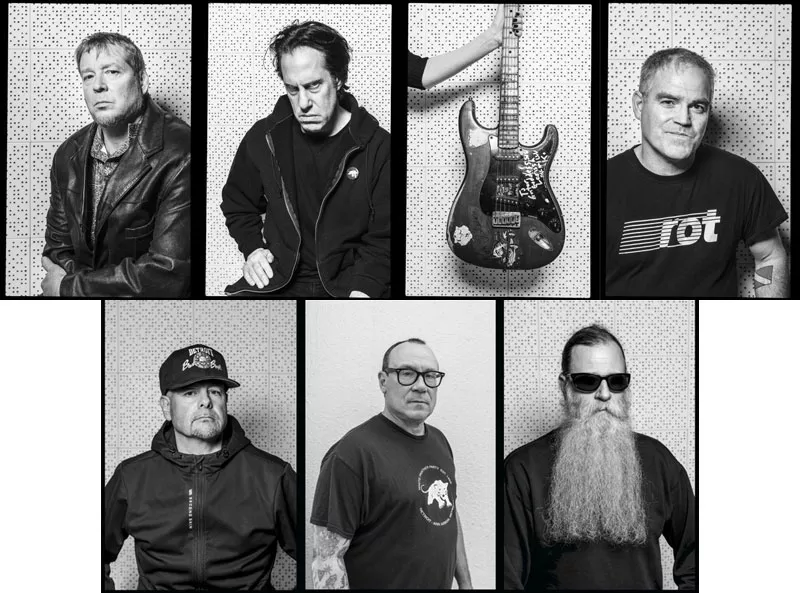
Touring to support Hard Times brings the band to an end.
John Brannon: At that point, we were kind of too deep into what we were doing to do anything else. We got into a heavy touring schedule. So it was like, yeah, I want to go straight, but I got this tour coming up, and it was physically impossible. There were times I wanted to quit and other people were doing it or other people quit and I was still doing it.
It really took a toll on my life. It ruined a lot of relationships. It ruined my relationship with my family. They disowned me. And I became a street person. We recorded Hard Times, and I was really off the deep end. I had gone through a bad breakup and being on the drugs I was really emotional to the point I just didn't give a fuck. I was borderline suicidal, and I eventually had to check myself into rehab. My mom actually helped me out. I had OD'd a few times, and I just really didn't care about anything. It was a really hard time in my life. We had just recorded Hard Times and I knew we were going to have to tour after that. So I was like, if I don't get straight, I'm going to be dead.
I remember I was in there for a 30-day program and I think Larissa broke me out about day 25 because she's like, "We gotta go on tour." So it was a real difficult tour. I stayed straight most of the tour but the big cities — it was hard. New York was hard. San Francisco was hard. L.A. was hard. And then there's always the story that I kind of OD'd at that Jabberjaw gig right before we went on and came into the club and puked on Drew Barrymore. That story's been told.
Metro Times: Stolarchuk and Swalla were still using on the tour?
John Brannon: Yeah, we all were to the end.
Ron Sakowski: I was just smoking weed and going, "Man, I'm not playing that slow."
Todd Swalla: [After the tour] I quit. I wanted to get away from drugs, basically. So I had to get away for a time if I wanted to get my act together. I was the first one to kind of bail. Then briefly, they got Damon Che from Don Caballero on drums for like a minute and he couldn't deal with the craziness so he bailed. They recorded a quick song with him. ["Shine," a bonus track on the Hard Times reissue.]
Also we had a whole European Hard Times tour all booked. It was like two months everywhere, John Peel sessions, the whole bit. So individually, Corey wanted to talk to all the band members. I just happened to be in Chicago. I was getting my passport expedited. I go in there and he totally does the, "So what's up with the drugs? Are you guys going to lay off in Europe or anything?" I was like, "I'm looking forward to it, I don't know anybody in Europe to score from. Hopefully I can just smoke some hash and drink some good beer." [Laughs.] He wasn't convinced enough, because they wouldn't come up with the money and we didn't have any money for plane tickets. They were going to advance us plane fare, but they wouldn't come up with it. That was kind of one of the reasons I quit, too. I'm like, "The record company has no faith in us, what's the point? I need to get away from this lifestyle anyway."‘Going through cold turkey in jail is not fun.’
tweet this
John Brannon: I always wanted to keep it together, but at that point I knew it was coming to an end. Even after we did that tour me and Ron have always been close and we never really broke up. Larissa had to go down to Florida and take care of her folks. And her mom had cancer and she was kind of up and down in Ann Arbor and in Florida, taking care of her folks. Then her dad died. So at that point, she was like, "I can't do it anymore. I'm in Florida." So nobody really quit. It just kind of fizzled. I mean, there was no big, "Fuck you. I quit." It just couldn't happen anymore.
In 1998 John Brannon would start a new band with Ron Sakowski called Easy Action. In 2000 he was busted for heroin possession in a sting outside Detroit's former Comet Bar.
John Brannon: Going through cold turkey in jail is not fun. There is a funny story though, about that. When I did get busted, they emptied my pockets. I had some guitar picks and they're like, "You a musician, kid?" I'm like, "Yeah." You know, I got my tail between my legs going, "Oh God, I'm going to jail and I've got a horrible heroin habit. I'm going to be sick as fuck." They're like, "Oh, OK, we're going to put you in the David Ruffin cell [of the Temptations], since you're a musician." Totally serious. And I go, "What?" They go, "Yeah, he was in here every other month, you know, because he had that crack problem." They gave me my own cell, man. That place was a fucking hole, man. And I had to go through cold turkey there. But you know, "We're going to put you in the David Ruffin cell." I thought that was kind of funny. You got to look back and laugh at some things. You know?
Metro Times: There's a video of you playing at the Gold Dollar with Easy Action right after your release, isn't there?
John Brannon: Yeah, that was a double release. I got released from jail and then I was playing the Gold Dollar for the Easy Action record release gig.
Going cold turkey in jail did the trick for Brannon. Swalla kicked heroin 19 years ago as well. Stolarchuk wasn't as lucky, dying from a suspected drug overdose Oct. 8, 2006. "I lost a true friend, my first love, my partner in crime," Brannon told Metro Times at the time. "I will always love you, Larissa."
Brannon has continued to perform with Easy Action and has also toured extensively with Negative Approach off and on since 2006. Last year, Brannon joined Dinosaur Jr. with Swalla on drums to do a surprise performance of the Hyenas' "Everything I Want" in San Francisco. But Brannon says fans shouldn't hold their breath for a full Laughing Hyenas reunion anytime soon.
John Brannon: To do a Hyenas reunion would be so disrespectful to the band. I mean, Larissa was such a major part of the band and nobody can play the way she does. It would just be a terrible thing to do, just out of respect for Larissa and the integrity of the band. For the fans and the history of the band it would just be a bad move. I have no interest.
Metro Times: Even though J. Mascis or Kim Gordon would probably step in for Larissa in a heartbeat?
John Brannon: Whatever guitar hero you can get, when it comes down to it, nobody can play guitar like Larissa. She's self-taught, she had her own style, and nobody can recreate that. I could never do it without her. You know, you got the records. Enjoy the records.
A reissue release party will take place at 7 p.m. on Saturday, Dec. 15 at Marble Bar; 1501 Holden St., Detroit; 313-338-3674; facebook.com/marblebardetroit. Limited edition versions of Life Of Crime and the Crawl/Hard Times re-issues will be available for purchase.
Get our top picks for the best events in Detroit every Thursday morning. Sign up for our events newsletter.
